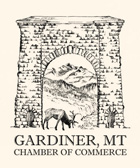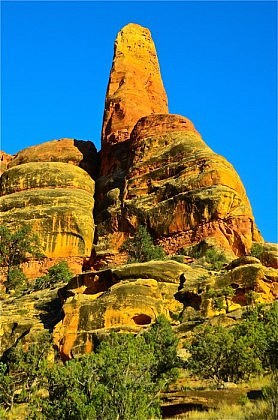As previously discussed, when it comes to climate and other human-induced influences and associated changes in grizzly bear nutrition, the times they are a’changin’.
Roots and berries are seasonal delicacies, and it’s likely that berry-producing plants in Yellowstone will decline as the climate becomes warmer and perhaps drier. Other plants will change their distribution, often moving up-slope in response to warming. As plant populations shift, scientists predict expanding infestations of non-native weeds, most of which are poor forage plants for wildlife, including grizzlies.
Since the early 1980’s, Greater Yellowstone grizzlies have feasted each summer on cutworm moths, which inhabit high elevation talus slopes east of the Continental Divide. Here are moths by the millions, a rich source of fat and protein for bears. It’s not known for certain why cutworm moths are such a recent addition to the grizzly diet. But because these insects migrate to agricultural areas of the Great Plains, they may have been temporarily decimated by the use of DDT, and then recovered after the pesticide was banned. In any event, at least for now, cutworm moths have been a great boon to the benefit of bears.
Our guided hikes in the Yellowstone high country may take you into the realm of the whitebark pine, a dominant high elevation tree. Whitebark pine is already declining in much of its range due to infestations of native bark beetles formerly controlled by prolonged outbreaks of severe arctic-like winter weather. It’s also under attack by the non-native blister rust fungus, which kills many, but not all, of its victims. Whitebark pine seed nuts are extremely nutritious for bears, squirrels, Clark’s nutcrackers and other wildlife. Whitebark Pine is likely to survive in the highest coldest habitats near tree-line and as scattered young stands (the bark beetles primarily attack older trees), but its future as a major food source for bears is uncertain, already considerably reduced from bygone days. That’s unfortunate both from the nutritional standpoint and because these nuts tend to keep bears up at high elevations, away from most humans. In years with poor cone crops, grizzly/human conflicts increase. That’s bad news for bears because when there’s a conflict, humans usually prevail and often, bears die.
Until recently, another great source of grizzly protein around Yellowstone lake was the cutthroat trout. These fish used to spawn each spring in great numbers in the feeder streams that flow into Yellowstone Lake. No more. That’s because in the 1980’s an unknown individual(s) introduced lake trout – a native of eastern Canada and the Great Lakes – into the ecosystem. Unlike the native cutthroats, lake trout inhabit and spawn in deep lake waters where they’re unavailable to predators like bald eagles, osprey and grizzlies. They don’t spawn in the streams. And they eat cutthroats to the extent that the native Yellowstone Cutthroat has nearly disappeared from the Yellowstone Lake ecosystem. That’s more bad news for bears. Although the Park Service is undertaking an expensive program to kill lake trout and rebuild the cutthroat population, the long term results are unknown and the cutthroat future remains in doubt.
As a result of reduced availability of fish and pine nuts, Yellowstone grizzlies are now eating more elk calves. That could have long term ecosystem ramifications regarding elk numbers and everything affected by elk. Eating fish and pine nuts does not create danger for sows and cubs by bringing them in contact with adult boars. But elk protein does. Adult boars will eat young cubs, even their own (human parents can sometimes understand this behavior). They are also a danger to the sows, and may run them off or even kill them. Being forced to rely more on elk protein might result in fewer bears plus smaller litters and reduced birth weight for grizzly cubs.
In summary, recent human-induced changes in the Yellowstone Ecosystem are already affecting grizzly feeding habits and behavior. Climate change tops the list. Bears are intelligent and adaptable, yes, but with dramatic reductions in the availability of some of their most abundant and nutritious foods, the future of the Yellowstone grizzly is by no means secure. Add to the food equation increased human population growth and residential development in the Greater Yellowstone area plus logging and oilfield development, and the future for Griz looks uncertain, to say the least. Moreover, many politicians and agency people are clamoring to remove the grizzly from the endangered species list (it’s currently listed as a “Threatened” species) and institute grizzly hunts! And finally, Yellowstone Ecosystem grizzlies are isolated from other grizzly populations, meaning that bears are vulnerable to inbreeding and potential environmental disasters that threaten small isolated populations. At the very least, all of these factors add up to a great reason to maintain the Griz as a “Threatened” species, to protect all remaining undeveloped wilderness quality lands, and to keep our precious designated wilderness areas as wild as possible.
Fairly, fitness and medicines are playing on the minds of people all around the World. Online drugstores provides best-quality recipe medicaments and other medications. One of the most popular drug is Viagra. This article tell more about “http://cialis-price.biz“. Nearly every man knows about “http://cialis-price.biz“. Other question we must is “http://cialis-price.biz“. Albeit sex is not vital for good heartiness, it’s no doubt good for you. Other medicaments may interact with this cure, including recipe herbal products. Not all feasible interactions are listed in rate medication guide. Stop using this remedy and get medic help if you have sudden vision loss.



